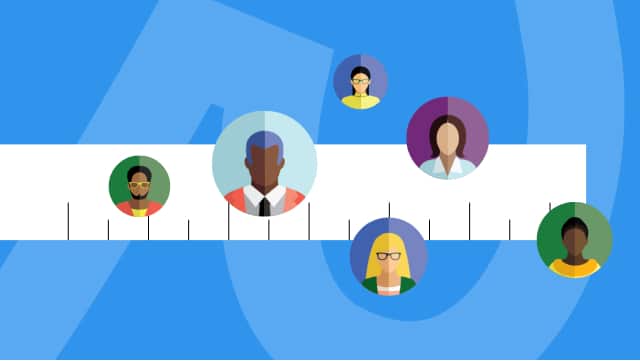Table of Contents
If your company is paying attention, then diversity, equity, and inclusion (DE&I) should be a huge topic for you right now. But how do you know if your efforts are moving the needle? Can you actually measure your diversity and inclusion outcomes?
This hands-on guide is designed to help you identify clear goals and see the measurable results of your DE&I programs. Ready to get started?
First, answer the three key questions below. Then, we’ll walk you through implementing the action steps from our Roadmap for Ending Unconscious Bias in the Workplace to identify bias at each stage of the employee lifecycle in your company. Finally, download our printable worksheets, linked at the end of each section, to assess and measure your response.
Read now: Roadmap for Ending Unconscious Bias in the Workplace

Getting started: Key questions
1. Define what diversity means to your company
Put down the dictionary — diversity means something different for every company, industry, and region. Hold a focus session with your HR team and leadership team in which you define what diversity means to you. Feeling stuck? Look at your workforce and identify the traits an overwhelming majority has in common. Diversity for you might mean the opposite.
Example areas:
- Race and ethnicity
- Is everyone white? That’s a problem. Figure out why, and fix it.
- Gender
- Remember, this isn’t just male vs. female — make sure transgender and agender candidates are comfortable applying to and working at your company as well.
- Sexuality
- You can’t (and shouldn’t) inquire about your employees’ sexuality — but to foster diversity, you are responsible for creating an inclusive workplace where all feel welcome.
- Age
- If everyone at your company is in Gen Z, you’re lacking business experience — but if everyone’s a Boomer, you’re going to fall behind on trends and tech.
- Education, training, and level of experience
- Advanced degrees? Boot camps? Military background? Strive for a diversity of training backgrounds for a well-rounded workforce that brings different perspectives to the table.
- Country and language of origin
- Does everyone at your company feel welcomed and included regardless of nationality? Do you have signs and messaging in multiple languages?
- Marital or parental status
- Do your benefits package and company culture attract or repel employees with families and dependents?
2. Clarify why you’re pursuing DE&I
This is a question every key stakeholder — not just HR staff, but every executive and member of leadership — should be able to answer. Why are you pursuing DE&I initiatives?
Why this matters: If your stakeholders don’t understand why they’re making a change, they won’t be bought in. And without buy-in, change can’t happen. At your focus session, brainstorm every reason to invest time and resources into DE&I initiatives — no matter how small. Then, as a group, select the top 2 or 3, and firm them into a statement of purpose. For example:
We are committed to increasing the diversity and inclusion efforts at our company [to broaden our talent pool in a competitive talent market, to better reflect and understand the needs of our customer base as we expand to diverse markets, and to improve employee retention among women and people of color specifically.
Why a statement of purpose? It gives you something clear to point to when the path ahead inevitably becomes murky. Give yourself something solid. Vague statements like “Because it’s the right thing to do” fall apart easily in the face of day-to-day challenges.
3. Define what you want to achieve with your DE&I efforts
As we’re fond of saying at WorkTango, you can’t improve what you can’t measure. Now is the time to define the metrics you’ll track for your DE&I program, using diversity as you defined it in Step 1.
Examples include:
- % of diverse hires
- % of diverse candidates applying for positions
- % of diverse members of leadership
- % of raises or promotions going to diverse candidates
All set? Check out our companion piece, A Roadmap for Ending Unconscious Bias.
Measuring DE&I in recruiting and hiring
1. Neutralize job descriptions
You may not realize it, but the language you use in job descriptions can signal “I don’t want you” to applicants right out of the gate. Task your recruiters and HR team with reading Glassdoor’s guide to remove bias in job listings.
Then, set a goal to update all job listings by the end of next quarter, and write a policy outlining language use in job listings going forward.
2. Implement blind resumes
Have your recruiters remove photos, names and addresses from resumes before they’re viewed by hiring managers. And delay social media checks until after the first interview. This prevents the “personal similarity bias” explained in our Roadmap.
Set a goal to have this as standard policy by the end of next quarter.
3. Lead with skills tests
Skills tests give you a clear insight into how well a candidate will do in a role, no matter their past education or experience. Learn more about skills tests from SHRM. Make a personal goal to present this to leadership by the end of next quarter for rollout by end of next year.
Measuring diversity and inclusion in onboarding
1. Lead with skills during introductions
Short and simple: When introducing a new member to the team, make it a policy to lead with that person’s skills rather than their educational background or hometown. Set a goal to educate hiring managers on this and update your onboarding policies by the end of next month.
2. Facilitate inclusivity events
Your hiring managers and HR teams should facilitate events for new hires and current employees to spend time together in a setting other than the workplace — ideally during the first week on the job. Need ideas? Check out Bustle’s list of Zoom happy hour ideas for work.
3. Develop mentorship programs
Partner new hires with an existing employee, or mentor, to help prepare them for their new responsibilities. How this helps with diversity, equity, and inclusion: The more quality time we spend with someone, the harder it is to other them. Set a goal to roll out a mentoring program by the end of the next half-year.
Measuring DE&I in employee performance conversations
1. Use technology to standardize performance reviews
Performance reviews are infamously prone to bias — so platforms like Worktango that standardize the review process are a huge help.
2. Incorporate peer feedback in the performance conversation process
Eliminate bias by gathering feedback from many different people, instead of just one. Set a goal of upgrading your performance review process to include peer feedback, as well as feedback from managers, by the end of the year.
3. Review regularly
It’s really, really time to ditch the annual review — not only are they unproductive and stress-inducing, but when managers review employees sporadically, they tend to make judgments on recent accomplishments and mistakes, rather than performance over time. Set a goal to move to a cycle of quarterly Check-Ins by the end of next year.
Measuring DE&I in development & career growth
1. Use data to drive decisions about employee career growth
Want to remove bias from deciding who gets that promotion? Use data. If you don’t have a tool in place to track employee accomplishments, constructive peer and managerial feedback, and other factors, get one. Set a goal to research options by the end of quarter and pitch it to leadership the quarter after that.
2. Standardize career growth
Make sure everyone’s on the same playing field: Devise a standard list of questions to ask when making a decision regarding a promotion. This ensures your decision is fair and inclusive — and well documented. Set a goal to devise the question list by end of quarter, and roll it out to hiring managers by the end of next quarter.
3. Track who gets mentorship opportunities — and if it’s unfair, fix it
Keep track of who in your company is being offered mentorships and growth opportunities, including conference funding, special training, and executive advising. At the end of each quarter, use our worksheet to examine who’s on that list. Don’t make excuses if the data shows you a truth you aren’t comfortable with — it’s time to keep calm and fix the issue.
Build inclusive workplaces with WorkTango
We hope this guide and associated worksheet set will help you track and measure diversity, inclusion, equity, and bias in your company. These are top concerns for organizations around the world, but being concerned is not enough. It is time to close the gap.
That’s where we come in.



